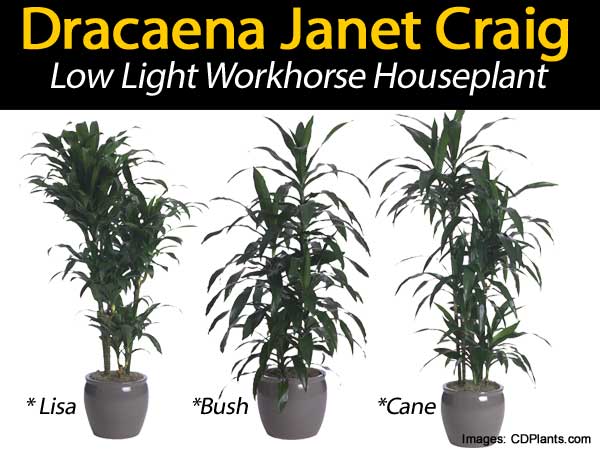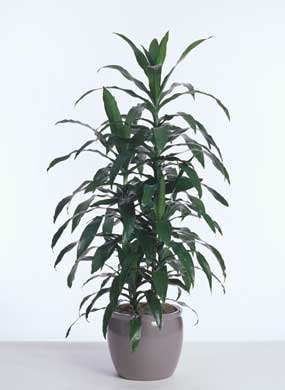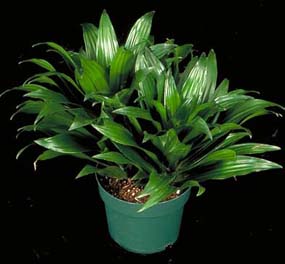Janet Craig Dracaena: Low Light Houseplant

Dracaena Janet Craig has been a favourite indoor workhorse for decades, often used as a floor plant in interior conditions or mass planted in beds. It can survive in low light conditions and grows best in filtered light.
Although this Dracaena may grow to be 15 feet tall in its native Africa, plants produced for indoor use are much smaller. Typically produced via tip cuttings, with three to four stalks or tips per container. Janet Craig plant has glossy, solid, broad, dark green leaves with wavy borders that are 3 inches wide and 2 feet long. Their tall, tapering leaves, pleated foliage, and deep green hues contribute to their appeal as indoor plants. Used extensively as indoor floor plants or for bulk planting in beds.
Quick Growing Guide
Botanical Name: Dracaena Janet Craig, dracaena warneckii
Genus: Dracaena
Sun / Shade:
Water: Only water when the top soil layer dries
Soil:
Height:
Width:
Care:

Most plants grown for interior use are 10 inch pots with 3 plants per pot, ranging in height of 24-32 inches. Some 14 inch pots are grown as well with 4 plants per pot and reach a height of 30-42 inches. When purchasing a bush form of “Janet Craig” Dracaena look for a plant whose width is 50-75% the plants height.
Over the last few years we have seen the introduction of Janet Craig cane-type plants enter the market from some Hawaiian growers. We see some taller plant sizes produced reaching heights of 6 – 8 feet in very small pots compared to their height. It should be noted, the correct botanical name for “Dracaena Janet Craig” is Dracaena deremensis “Janet Craig” and known throughout the plant industry simply as “Janet Craig”.
The history or “beginnings” of Janet Craig goes back to the 1930’s or so. “Janet Craig” is actually a ‘sport’ or a variant of Dracaena Warneckii and was named after the daughter of nurseryman Robert Craig, who lived in the Philadelphia area.
Light Requirements Indoors
Janet Craig Dracaena, like understory plants, is a good low-light indoor plant. When you combine her capacity to withstand low humidity, air conditioning, and little care, you have the makings of an extremely long-lasting indoor plant. It can survive in low light conditions but grows best in filtered sunshine.
Janet Craig Hates Heat – Temperatures
Dracaena deremensis cultivars do not like heat. This is very important to remember, especially during the summer months when plants have a tendency to discolor. The recommended maximum temperature is 90 degrees. As temperatures increase above 95 degrees, problems with leaf discoloration and leaf notching may develop.
In the nursery, Janet Craig grew in deep shade, not because the plants wanted low light. Growers shade Janet Craig more for temperature control than to reduce actual light levels. Janet Craig shows little growth below 70 degrees. Cold damage can occur around 35 degrees or if plants are exposed to 55 degrees or lower for a week.
Watering Requirements
Allow the soil to dry between 1/3 to 1/2 down before watering. Do not let your plant sit in water. Water thoroughly and remove the excess water from the saucer or bottom of the decorative container. The plant will tolerate considerable dryness. You will do much better keeping Janet Craig on the dry side. Janet Craig is an excellent candidate for sub-irrigation.
Janet Craig and Dracaena Warneckii have almost two root systems. The main root and the finer secondary roots. Make sure the fine secondary roots are healthy if you want to keep a healthy plant. If the secondary roots experience problems, the plant quality will go down hill quickly.
Soil Recommendation
Janet Craig needs a well drained potting medium, such as a mixture of peat and pine bark with perhaps 10% sand.
Pruning and Grooming Janet Craig
The leaves over time will collect dust, using a feather duster regularly will help keep foliage clean. Trim brown tips and edge of leaves to a natural contour with scissors.
Fertilizing
Do not fertilize your Dracaenas unless you use the correct fertilizer and understand the plant completely.
Janet Craig, like other Dracaenas, is fluoride sensitive. The use of fertilizers often raises the risk of salt harm. Fertilizers deposit salt in the soil. The salts are taken up by the roots and transported to the leaves. These “salts” build up in the leaf tips over time, and the salt levels grow too high, scorching the leaf tissues and turning the leaf tips brown.
Pests – Mealybugs, Spider Mites, Thrips

Janet Craig has a low number of insect pests. Scales and mealybugs are a recurring issue. Mealybugs are distinguished by their white, cottony bulk that move slowly. If you’re having problems with insects or pests on your Dracaenas or other home plants, take some time to understand some pest management principles.
Varieties and Sports
There are several “new” varieties of Janet Craig which have been introduced over the past few years. Primarily these have come from the Hawaiian growers who discovered these new “sports” in the production process.
Dracaena Lisa
Dracaena Lisa, another great low-light plant, looks like Janet Craig at first glance, but is substantially narrower. Dracaena Lisa differentiates itself with beautiful dark green foliage linked to its distinctive green trunk. Lisa is an upright columnar plant that seldom grows taller than 8 feet. It has only been cultivated in Hawaii, and supplies may be scarce. Dracaena Lisa’s green trunks and upright growth patterns made them ideal cane plants.
“Exotic” Dracaena Lisa canes make a nice focal point in easily seen areas at home. A combination of Dracaena Lisa in staggered canes or various heights make them very attractive even in narrow spots in offices or buildings.
Dracaena Michiko
Dracaena michiko is one of the most sought-after dracaena hybrids in the world. This wonderful plant is brought from Hawaii and is also known as Michiko Cane because of its cane-like shape generated by its upright growing pattern. This plant’s leaves are more tightly bound to its stem. This makes the plant ideal for use in tiny or compact spaces or rooms with limited accessible space. Because of their wide, well-developed root system, Dracaena Michiko plants growing in Hawaii appear to have a longer life expectancy. The huge, full-grown appearance in smaller pot sizes means less money spent on pots or ornamental containers. Michiko’s tall, upright, or columnar growth makes them ideal for regions with limited space.
Janet Craig ‘Compacta’

Janet Craig ‘Compacta’ is a one-foot-tall bird nest-like shrub with little leaves. Compacta is a smaller version of Janet Craig. This cultivar grows slowly and is exceptionally hardy. It has been around for around 25 years. We’ve seen it cultivated as a low tabletop plant in 6-inch pots, as well as in multiples of three in bigger pots.







Leave a Reply
You must be logged in to post a comment.